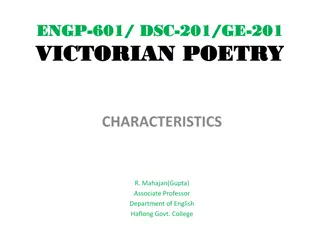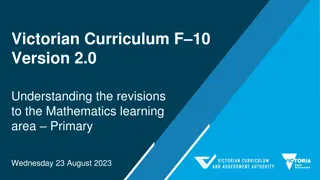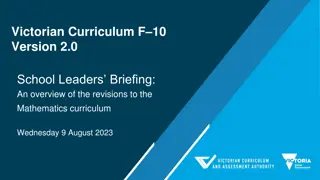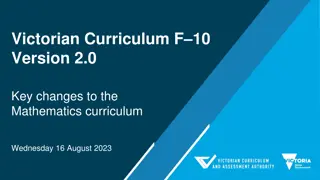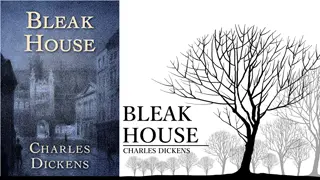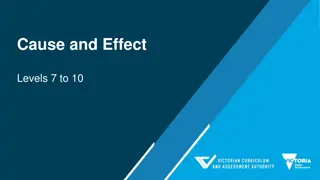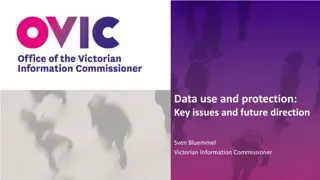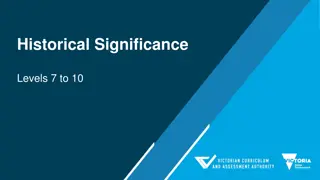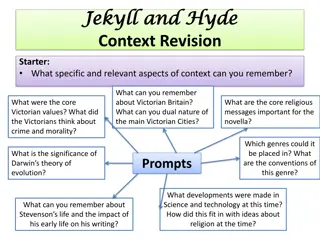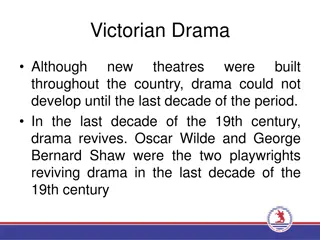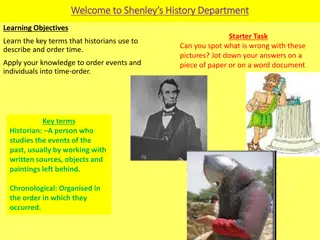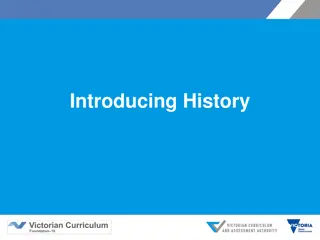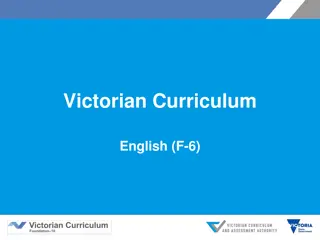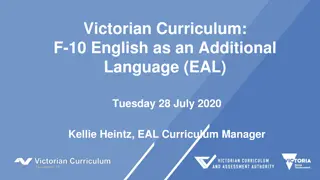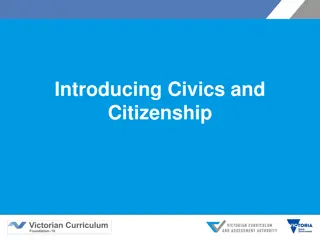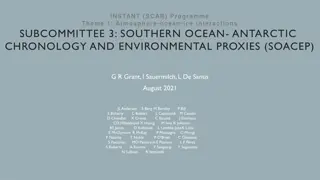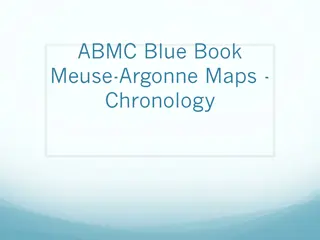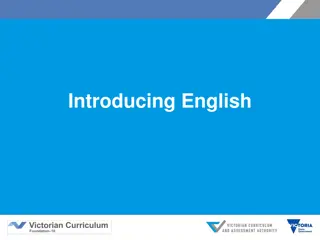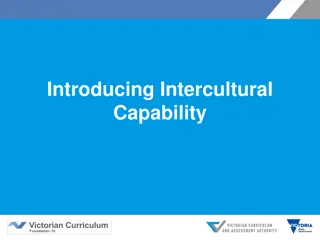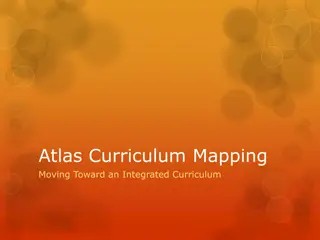Understanding Chronology in the Victorian Curriculum History
Chronology is essential in historical reasoning, providing structure for organizing historical thought. The Victorian Curriculum History emphasizes the sequencing of events to analyze causality, continuity, and change, enabling students to develop explanatory narratives about the past.
Download Presentation

Please find below an Image/Link to download the presentation.
The content on the website is provided AS IS for your information and personal use only. It may not be sold, licensed, or shared on other websites without obtaining consent from the author. Download presentation by click this link. If you encounter any issues during the download, it is possible that the publisher has removed the file from their server.
E N D
Presentation Transcript
Chronology Levels 7 to 10
Introduction Provocation Chronology in the curriculum context Chronology in Victorian Curriculum History Chronology in the continuum of learning Towards the classroom Examples of practice Conclusion
Chronological thinking is at the heart of historical reasoning. Without a clear sense of historical time time past, present, and future students are bound to see events as one great tangled mess. Without a strong sense of chronology of when events occurred and in what temporal order it is impossible for students to examine relationships among them or to explain historical causality. Chronology provides the mental scaffolding for organizing historical thought. Stephane Levesque, Thinking Historically: Educating Students for the Twenty-First Century
Chronology in Victorian Curriculum History
Victorian Curriculum History Learning in History Achievement Standard Skill/Concept Historical Knowledge
Learning in History Chronology involves the arrangement of events in order of time. However, the sequencing of events is not an end in itself. It allows students to understand the sequence and flow of events and identify patterns of continuity and change, analyse cause and effect, distinguish between long- term causes and short-term triggers and provides the starting point and basis of explanatory narratives about the past. Victorian History Curriculum, Learning in History: Sequencing Chronology
Achievement Standard Levels 7 and 8 Achievement Standard Levels 9 and 10 Achievement Standard Students sequence events and developments within a chronological framework with reference to periods of time. Students sequence events and developments within a chronological framework, and identify relationships between events across different places and periods of time.
Historical Concepts and Skills: Chronology Levels 7 and 8 Sequence significant events in chronological order to analyse the causes and effects and identify continuities and changes (VCHHC097) Levels 9 and 10 Sequence significant events in chronological order to support analysis of the causes and effects of these events and identify the changes they brought about (VCHHC121) Describe and explain the broad patterns of change over the period from the Ancient to the Modern World (VCHHC098) Analyse and evaluate the broad patterns of change over the period 1750 present (VCHHC122)
Connections Levels 7 and 8 Chronology Sequence significant events in chronological order to analyse the causes and effects and identify continuities and changes (VCHHC097) Chronology connects with: other Historical Concepts and Skills historical content knowledge instructional terms. Describe and explain the broad patterns of change over the period from the Ancient to the Modern World (VCHHC098)
Connections: your turn Levels 9 and 10 Identify: other Historical Concepts and Skills historical content knowledge instructional terms. Sequence significant events in chronological order to support analysis of the causes and effects of these events and identify the changes they brought about (VCHHC121) Analyse and evaluate the broad patterns of change over the period 1750 present (VCHHC122)
Continuum of learning Levels 5 and 6 Levels 7 and 8 Levels 9 and 10 Achievement Standard Achievement Standard Achievement Standard Students sequence events and developments within a chronological framework, and identify relationships between events across different places and periods of time. Students sequence events and people (their lifetime) in chronological order, and represent time by creating timelines. Students sequence events and developments within a chronological framework with reference to periods of time. Historical Concepts and Skills Sequence significant events in chronological order to analyse the causes and effects and identify continuities and changes (VCHHC097) Describe and explain the broad patterns of change over the period from the Ancient to the Modern World (VCHHC098) Historical Concepts and Skills Sequence significant events in chronological order to support analysis of the causes and effects of these events and identify the changes they brought about (VCHHC121) Analyse and evaluate the broad patterns of change over the period 1750 present (VCHHC122) Historical Concepts and Skills Sequence significant events and lifetimes of people in chronological order to create a narrative to explain the developments in Australia s colonial past and the causes and effects of Federation on its people (VCHHC082)
Sequencing Chronology and Historical Knowledge Where is chronology explicit? Use this structure to break down the knowledge content descriptions to understand the application of the skill. Where is there an opportunity for chronology? Where is chronology implied? Historical Knowledge Where is chronology necessary?
Sequencing Chronology and Historical Knowledge Australia at war (1914 1945): World War I Causes of World War I, the reasons why men enlisted to go to war, and how women contributed in the war effort (VCHHK139) Significant places where Australians fought and explore their perspectives and experiences in these places (VCHHK140) Effects of World War I, with a particular emphasis on the changes and continuities brought to the Australian home front and society (VCHHK142) Significance of World War I to Australia s international relationships in the twentieth century, with particular reference to the Britain, the USA and Asia (VCHHK143) Different historical interpretations and contested debates about World War I and the significance of Australian commemorations of the war (VCHHK144)
Towards the classroom Levels 7 and 8 Students think about chronological sequencing on several levels. They encounter big picture ideas such as the history of human civilisation and the contribution of archeology to our understanding of the past. Sequencing chronology helps students understand the patterns and commonalities across the societies they investigate and consider their legacies in the present day. For their study of a specific society, students use key dates to understand and create narratives about leadership, architectural features, conflicts, the spread of religious ideas, trade and exploration. Students are introduced to the conventions of reading and writing about chronology. This includes the use of BCE (Before Common Era) and CE (Common Era), and terms such as the 20th century to describe the period from 1900 to 2000. They also become adept at applying terms to describe time, such as long term and short term.
Towards the classroom Levels 9 and 10 At this level, sequencing chronology underpins students sophisticated historical thinking. Students are placing events in order so that they can interrogate that order for meaning to chart patterns of change, to identify long-term causes and effects, to judge whether an event was truly significant. Sequencing chronology ensures students do not perceive history as an endless series of fragmented vignettes but as a rich and complex narrative that can be understood. It prevents students from falling into simple errors about the flow of causation and influence. It allows students to see the deep tides of change that produce ripples in different countries and historical periods.
Indicative examples By the end of Level 8: By the end of Level 10: students use timelines to identify patterns of change over time students use timelines to identify sequences of causation and consequences students explain broad patterns over large time periods in a written response students use timelines to identify significant events in the life of key individuals. students use timelines to map broad patterns of change over time students use timelines to link sequences of causation and consequences to historical events students demonstrate an understanding of the sequence of events in structured written responses students use timelines to identify significant events in the life of key individuals.
Language of Chronology Date Timeline Circa Year Order Relationship Parallel Causes Consequences Connection Time Prehistory Annotated Epoch Century Decade Sequence Chronology Before After Next Earlier Long term Short term
Classroom ideas Levels 7 and 8 Levels 9 and 10 Create an enhanced timeline and annotate it to identify patterns over time. Write a piece of historical fiction that sequences events in their correct order. Play a mix-and-match game where students must sequence events in the correct order. Create an enhanced timeline and annotate it to identify changing patterns over time. Produce a structed piece of writing that demonstrates an understanding of chronology. Create an infographic that identifies relevant events.
Example of practice Levels 7 and 8
2 Activity Key question: How can we use timelines to understand the past? Activity: Use the following slides and Levels 7 and 8: Chronology Student Handout to assess your students understanding of chronology.
3 Sequencing Chronology
4 A chronology of Japan under the Shoguns (c.794 1867)
5 empire emperor feudalism daimyo shogun sakoku divine wind shogunate imperial rule civil war dynasty sovereign We will need to understand the meaning of these words to learn about Japan under the Shoguns
6 Emperor Go-Daigo overthrows Kamakura shogunate Shogun Yoshimitsu unifies Japan again Warring States period begins Minamoto no Yoritomo becomes shogun 1333 AD 1392 AD 1337 AD 1467 AD 1185 AD Emperor Go-Daigo is challenged by Muromachi shogunate civil war follows
Example of practice Levels 9 and 10
2 Activity Key question: How can timelines help us consider new links between events? Activity: Use the following slides to assess your students understanding of chronology.
3 Vocabulary Activist Segregation Interracial Reconciliation Ku Klux Klan Freedom Rides Fellowship of Reconciliation Deep South CORE SNCC SAFA Reserve
4 Sequencing Chronology
5 Sequencing Chronology: The Freedom Rides
6 As historians, it is important to know the order of events as that can help us come to a greater understanding of what occurred, evaluate its significance or impact, and identify links between events.
7 Timeline activity: What new things do we learn by considering the sequence of events? What new questions or analysis are inspired by understanding the sequence of events?
Discussion points How often do your students return to creating timelines or tables to help them understand the period they are studying? Do you ask students to describe the criteria they are using to decide which events or turning points are significant enough to be included in their timelines? Does your class play with different modes and presentation formats for timelines, analysing which are most useful for a particular investigation? What is the most powerful, informative timeline that you have ever developed with your students? Once a timeline is complete, do you press your students to analyse what light it shines on the narrative? How can we ensure that student-produced timelines are rich tasks and not just a series of dates and facts taken from Wikipedia? How do we design activities that cater for a wide range of learners?
Reflection activity Use the following thinking routine to reflect: What excites you about this idea? What do you find worrisome? What else do you need to know? What is your current stance or opinion?


